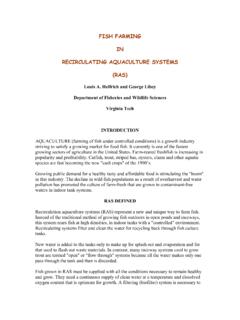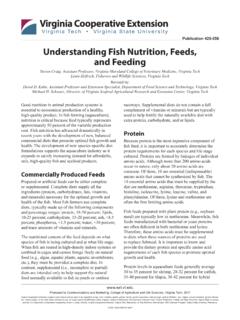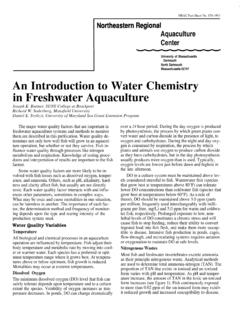Transcription of Introduction to Freshwater Fish Parasites
1 CIR716 Introduction to Freshwater fish Parasites 1 RuthEllen Klinger and Ruth Francis Floyd21. This document is CIR716, one of a series of the Fisheries and Aquatic Sciences Department, Florida Cooperative Extension Service, Institute of Food and Agricultural Sciences, University of Florida. First published March 1987 by Frederick J. Aldridge and Jerome V. Shireman; Reprinted April 1994. Reviewed May 2009 and June 2013. Visit the EDIS website at RuthEllen Klinger, biological scientist, Department of Large Animal Clinical Sciences (College of Veterinary Medicine) and Ruth Francis Floyd, associate professor, Department of Fisheries and Aquatic Sciences (Institute of Food and Agricultural Sciences), Department of Large Animal Clinical Sciences (College of Veterinary Medicine), Cooperative Extension Service, Institute of Food and Agricultural Sciences, University of Florida, Gainesville, 32611.
2 The Institute of Food and Agricultural Sciences (IFAS) is an Equal Opportunity Institution authorized to provide research, educational information and other services only to individuals and institutions that function with non-discrimination with respect to race, creed, color, religion, age, disability, sex, sexual orientation, marital status, national origin, political opinions or affiliations. Department of Agriculture, Cooperative Extension Service, University of Florida, IFAS, Florida A&M University Cooperative Extension Program, and Boards of County Commissioners Cooperating. Nick T. Place , DeanIntroductionFish culture as a hobby or business is well established in Florida. Increased interest in fish culture has also increased awareness of and experience with Parasites that affect fish health, growth, and survival. Information provided in this circular is intended for the novice fish culturist as a guide to common Parasites of Freshwater fish .
3 Identification of Parasites and their basic treatment is included; however, this information should not be substituted for consultation with an experienced fish health professional. NOTE: Mention of drugs or chemicals in this publication in no way represents a recommendation for their use, nor does it imply that they are approved for use by the Food and Drug Administration or the Environmental Protection Agency. This circular covers the following topics and species: I. Identification of a Parasitic Problem II. Protozoa A. Ciliates 1. Ichthyophthirius multifiliis 2. Chilodonella 3. Tetrahymena 4. Trichodina 5. Ambiphyra 6. Apiosoma 7. Epistylis 8. Capriniana 9. Treatment of Ciliated Protozoan Infections B. Flagellates 1. Hexamita / Spironucleus 2. Ichthyobodo 3. Piscinoodinium 4.
4 Cryptobia C. Myxozoa D. Microsporidia E. Coccidia III. Monogenean Trematodes IV. Digenean Trematodes V. Nematodes A. Camillanus B. Capillaria C. Eustrongylides VI. Cestodes VII. Parasitic Crustacea A. Ergasilus B. Lernaea C. Argulus VIII. Leeches IX. Conclusion 2 Introduction to Freshwater fish Parasites Identification of a Parasitic ProblemA common mistake of fish culturists is misdiagnosing disease problems and treating their sick fish with the wrong medication or chemical. When the chemical doesn t work, they will try another, then another. Selecting the wrong treatment because of misdiagnosis is a waste of time and money and may be more detrimental to the fish than no treatment at all. The majority of fish Parasites can only be identified by the use of a microscope. If a microscope is unavailable, or the person using it has no previous experi-ence with one, the diagnosis is difficult and questionable.
5 Successful fish culturists learn by experience. Newcomers to the field need to learn the fundamentals of diagnostic procedures and how to use a microscope to identify Parasites by attending short training courses. The following descriptions of common Parasites can be used as references for understanding a professional diagnostic report or as a quick reference for the experienced fish culturist. ProtozoaMost of the commonly encountered fish Parasites are protozoans. With practice, these can be among the easiest to identify, and are usually among the easiest to control. Protozoans are single-celled organisms, many of which are free-living in the aquatic environment. Typically, no intermediate host is required for the parasite to reproduce (direct life cycle). Consequently, they can build up to very high numbers when fish are crowded causing weight loss, debilitation, and mortality.
6 Five groups of protozoans are described in this publication: ciliates, flagellates, myxozo-ans, microsporidians, and coccidians. Parasitic protozoans in the latter three groups can be difficult or impossible to control as discussed below. CiliatesMost of the protozoans identified by aquarists will be cili-ates. These organisms have tiny hair-like structures called cilia that are used for locomotion and/or feeding. Ciliates have a direct life cycle and many are common inhabitants of pond-reared fish . Most species do not seem to bother host fish until numbers become excessive. In aquaria, which are usually closed systems, ciliates should be eliminated. Uncontrollable or recurrent infestations with ciliated protozoans are indicative of a husbandry problem. Many of the Parasites proliferate in organic debris accumulated in the bottom of a tank or vat. Ciliates are easily transmitted from tank to tank by nets, hoses, or caretakers wet hands.
7 Symptoms typical of ciliates include skin and gill irritation displayed by flashing, rubbing, and rapid breathing. IchthyophthIrIus multIfIlIIsThe disease called Ich or white spot disease has been a problem to aquarists for generations. fish infected with this organism typically develop small blister-like raised lesions along the body wall and/or fins. If the infection is restricted to the gills, no white spots will be seen. The gills will appear swollen and be covered with thick mucus. Identification of the parasite on the gills, skin, and/or fins is necessary to conclude that fish has an ich infection. The mature parasite (Figure 1) is very large, up to 1000 m in diameter, is very dark in color due to the thick cilia cover-ing the entire cell, and moves with an amoeboid motion. Classically, I . multifiliis is identified by its large horseshoe-shaped macronucleus.
8 This feature is not always readily visible, however, and should not be the sole criterion for identification. Immature forms of I . multifiliis are smaller and more translucent in appearance. Some individuals have suggested that the immature forms of I . multifiliis resemble Tetrahymena. Fortunately, scanning the preparation will usually reveal the presence of mature Parasites and allow confirmation of the diagnosis. If only one parasite is seen, the entire system should be treated immediately. Ich is an obligate parasite and capable of causing massive mortality within a short time. Because the encysted stage (Figure 2) is resistant to chemicals, a single treatment is not sufficient to treat Ich . Figure 1. 3 Introduction to Freshwater fish Parasites Repeating the selected treatment (Table 1) every other day (at water temperatures 68--77 F) for three to five treatments will disrupt the life cycle and control the outbreak.
9 Daily cleaning of the tank or vat helps to remove encysted forms from the environment. For more information, see Exten-sion Circular 920, Ichythyophthirius multifiliis (White Spot) Infections of fish . chIlodonellaChilodonella is a ciliated protozoan that causes infected fish to secrete excessive mucus. Infected fish may flash and show similar signs of irritation. Many fish die when infestations become moderate (five to nine organisms per low power field on the microscope) to heavy (greater than ten organisms per low power field). Chilodonella is easily identified using a light microscope to examine scrapings of skin mucus or gill filaments. It is a large, heart-shaped ciliate (60 to 80 m) with bands of cilia along the long axis of the organism (Figure 3). The organism is easily recognized at 100X magnification. Chilodonella can be controlled with any of the chemicals listed in Table 1, and one treatment is usually adequate.
10 Chilodonella has been eliminated in tanks using recirculating water systems by maintaining salt solution. tetrahymenaTetrahymena is a protozoan commonly found living in organic debris at the bottom of an aquarium or vat. Te t r a-hymena is a teardrop-shaped ciliate (Figure 4) that moves along the outside of the host. The presence of Tetrahymena on the body surface in low numbers (less than five organ-isms per low power field) is probably not significant. It is commonly found on dead material and is associated with high organic loads. Therefore, observing Tetrahymena on fish , which have been on the tank bottom, does not imply the parasite is the primary cause of death. One treatment of a chemical listed in Table 1 should be adequate for control. Identification of Tetrahymena internally is a significant but untreatable problem. A common site of internal infection is the eye.









